Test Drive: 2012 Fisker Karma
The new plug-in hybrid integrates recycled materials with high design and performance to reach a class of its own

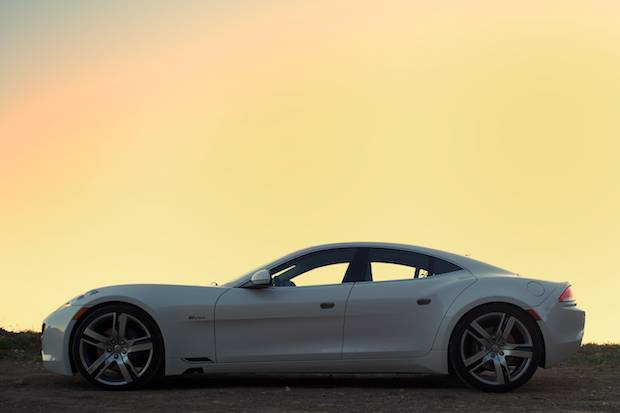
Those looking to spend $100,000 on a car have many options—excellent performance, coddling comfort, strong styling and luxury hybrids. The Fisker Karma EVer appeals to those who seek all of those, but are willing to meet somewhere in the middle. It isn’t the fastest or best performing in that price range, the most luxurious, or the hybrid with the best mileage. It is, however, a hugely impressive and attractive car from a new and interesting manufacturer that delivers enough of each of those components to make it a unique and obvious choice for many potential buyers. This new company seeks to increase the use of recycled materials and to decrease impact, wherever possible. Partners and suppliers are selected for their responsible business practices, and even its dealers need to get on the program—showrooms must be renovated, not built from scratch.
Building a car is an incredibly complex process that takes some of the world’s best design and engineering talent years, leveraging well-established systems and manufacturing techniques, years to create. Starting a new automobile company from scratch outside of the very small-scale, niche market is something that is very rarely endeavored given the complexity and enormous cost involved.

Southern California-based Fisker was created in 2007 by two auto industry vets and longtime associates—Henrik Fisker (who led design of the Z8 at BMW, was president and CEO of BMW’s DesignworksUSA, creative director at Ford’s London design center, chief of design at Aston Martin, and director of Ford’s Global Advanced Design Studio) and Bernhard Koehler (who similarly held senior positions at BMW as well as its DesignworksUSA division, Ford’s London design center, and was director of operations and business at Ford’s Global Advanced Design Studio). In 2008 they debuted the Fisker Karma concept, the world’s first luxury plug-in hybrid car, inspired by technology created for the U.S. military.
Four years later, delivery of the production Karma has begun, and its first customers—European royals and Hollywood celebrities among them—can be spotted driving one of the most attention-getting cars on the road today. I had the opportunity to test the Karma in Los Angeles, meet many of the company’s executives, and experience the car firsthand.

The Fisker Karma EVer (Electric Vehicle with extended range) is a $100,000, four-door, four-seat, luxury plug-in hybrid with a very strong presence. It can travel up to 50 miles on a full charge of its 180 kW, 20 KWh lithium-iron phosphate battery pack, meaning that most people commuting to work will never need the turbocharged 2.0 liter, four cylinder, 260-hp gas-powered engine (sourced from GM). If needed, the engine powers the generator, which in turn powers the two rear-mounted electric motors that drive the rear wheels, and the car can travel around 250 additional miles. This “series hybrid” design is unique to the Karma.
The motors generate around 400hp and 981 lb-ft of torque (the Ferrari 458 Italia, by comparison, generates around 400 lb-ft, and the Tesla Roadster Sport around 225 lb-ft). Electric engines are able to access all of that torque on demand, and that means the Karma is perky (though not fast), despite its 5,500-lb heft (as much as many large SUVs). The batteries, solar panel roof, engine, motors and generator create a heavy payload, one that some people believe impedes its performance and desirability. While true, those buyers are not the ones entranced by the Karma’s styling, 22″ Batmobile-like Circuit Blade wheels and Goodyear Eagle F1 Supercar tires.
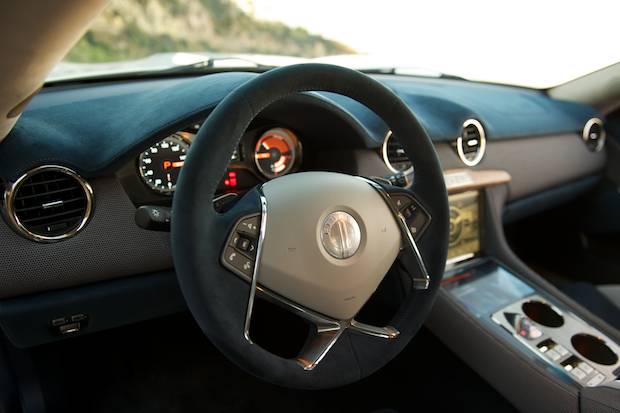
The inside of the car makes as much of a statement. Available in three interior trim packages, the base EcoStandard, the EcoSport and the EcoLux (which is what I drove). Each features only reclaimed wood from fallen trees from forest fires, and even from the bottom of Lake Michigan, where 300-year-old wood is retrieved from yesteryear’s lumber mill scrap. Though limited in its use, the wood takes center stage in the cabin. The simple and natural finish—you won’t find any glossy lacquer here—is unique, subtle and luxurious.
The EcoStandard features artificial leather, and the EcoSport Low Carbon Leather—Farm Animal Welfare-certified hides which are organically tanned with ecologically harvested bark extract by seventh-generation Scottish leather firm Bridge of Weir. The perfection you’d find in a Bentley’s leather trim is traded for the natural beauty of the cow’s hide. Around 85% of the hide is used (substantially more than usual), imperfections and all. Interior colorways are fresh and innovative, too. The firm’s plant supplies its own steam-generated power and processes its waste water.
The EcoLux features a totally animal-free automobile interior along with an “EcoSuede” made entirely of recycled materials. All packages include soy-based foam in the seats and carpet made with recycled materials. Though the rear seats provide enough room for adults, they aren’t very comfortable to sit in for long periods of time.
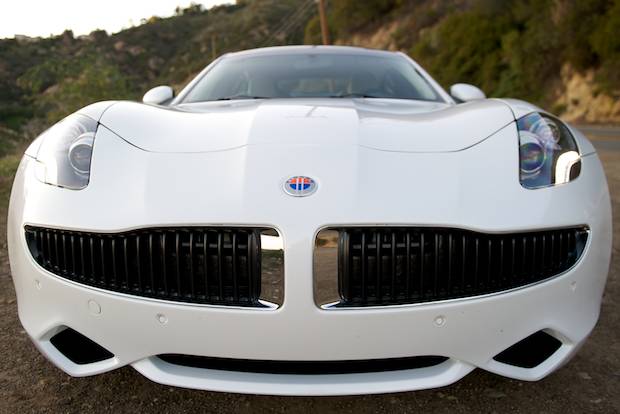
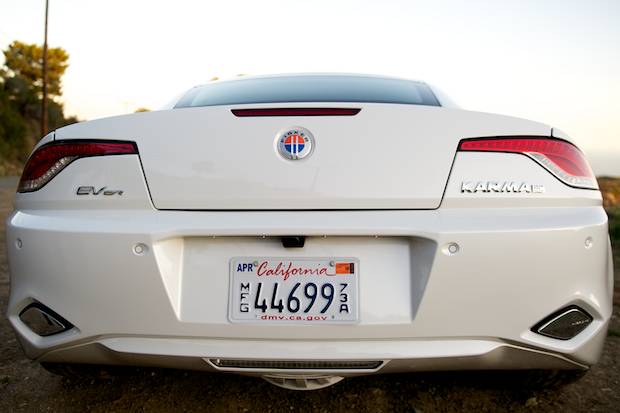
All packages share the same electronics, and here too Fisker has innovated with a 10″ haptic touch screen to control all aspects of the car’s entertainment and operational systems. In fact the Karma has only four buttons—one for the locks, one for the glove box, one for the hazard lights and one for power. The dash’s lack of switches and buttons is not just a nod to electronics—Fisker intentionally sought to eliminate the loop involved in manufacturing, shipping, maintaining and ultimately disposing of landfill-destined plastic and wire components. The “Command Center” system, designed with Visteon, is user-friendly and well executed, though may take some getting used to by those who are less comfortable or familiar with digital interfaces. My phone paired quickly and easily, and the Bluetooth system supports audio. Key functions are easily accessed without painful menu layers, and it serves as a display when the car is in reverse. The car’s sound system is acceptable but far from industry-leading. The car features low-voltage LED lighting wherever possible, further reducing demand on the car’s electrical system.
Some of the power for the car’s systems is created by its “retro-geometric”-patterned 120-watt solar roof panel (the largest and most powerful in any automobile), which both extends battery range and makes a clear design statement. Parked in the sun? The Karma leverages that electric power to ventilate the car’s interior. Fisker estimates that around 200 miles of zero-emissions driving are created from the car’s roof, making it “the only car with a sunroof for the 21st century.”
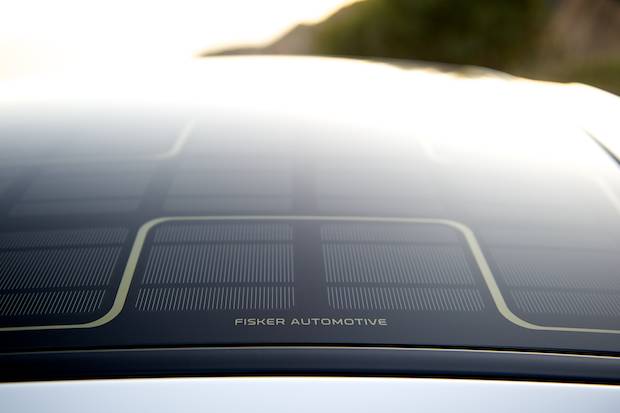
The Karma performed as well in LA traffic as the twisting canyon roads of Malibu, providing a respectfully sticky ride that doesn’t disappoint, especially for a a sedan of its size. Those big wheels feature Brembo monobloc caliper brakes, which easily bring the car to a quick standstill, and the regenerative braking system takes that energy and directs it to help power a generator where it can be reused.
The Karma fully charges in about 14 hours with a standard 100v plug, or around 6 hours with a 220v plug.
Designed and engineered in Anaheim, CA, the Karma is built by Valmet, the respectable Finnish producer, who until last year produced the Porsche Cayman and Boxter. Fisker has purchased an old GM plant in New Hampshire which it intends to renovate and use to build its next model, the Nina.
The Karma introduces to the sometimes predictable luxury auto market a truly innovative new option from a refreshingly young company, and certainly fulfills a need for the more thoughtful consumer with six figures to spend on an equally conscious car.
Photos by Evan Orensten












